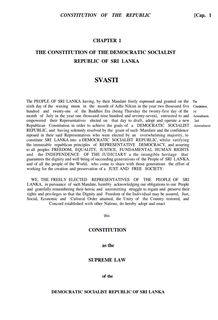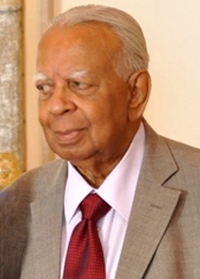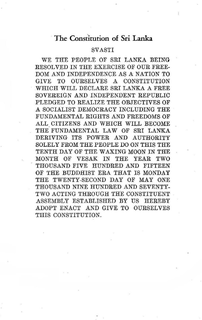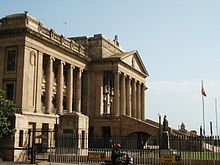
The Government of Sri Lanka (GoSL) is a parliamentary system determined by the Sri Lankan Constitution. It administers the island from both its commercial capital of Colombo and the administrative capital of Sri Jayawardenepura Kotte.

The President of Sri Lanka is the head of state, chief executive, and de jure head of government of the Democratic Socialist Republic of Sri Lanka. The president is the chief executive of the union government and the commander-in-chief of the Sri Lanka Armed Forces.

The Parliament of the Democratic Socialist Republic of Sri Lanka is the supreme legislative body of Sri Lanka. It alone possesses legislative supremacy and thereby ultimate power over all other political bodies in the island. It is modeled after the British Parliament.

The Governor-General of Ceylon was the representative of the Ceylonese monarch in the Dominion of Ceylon from the country's independence in 1948 until it became the republic of Sri Lanka in 1972.

The Supreme Court of Sri Lanka is the highest court in Sri Lanka and the final judicial instance of record. Established in 1801 and empowered to exercise its powers subject to the provisions of the Constitution of Sri Lanka, the Supreme Court has ultimate appellate jurisdiction in constitutional matters and takes precedence over all lower courts. The Sri Lankan judicial system is a complex blend of common law and civil law. In some cases, such as those involving capital punishment, the decision may be passed on to the President of Sri Lanka for clemency petitions. The current Chief Justice of Sri Lanka is Jayantha Jayasuriya.

The State Council of Ceylon was the unicameral legislature for Ceylon, established in 1931 by the Donoughmore Constitution. The State Council gave universal adult franchise to the people of the colony for the first time. It replaced the Legislative Council of Ceylon, the colony's original legislative body.

The Constitution of the Democratic Socialist Republic of Sri Lanka has been the constitution of the island nation of Sri Lanka since its original promulgation by the National State Assembly on 7 September 1978. As of August 2020 it has been formally amended 20 times.

Samuel James Veluppillai Chelvanayakam was a Malaysian-born Ceylonese Tamil lawyer, politician and Member of Parliament. He was the founder and leader of the Illankai Tamil Arasu Kachchi (ITAK) and Tamil United Liberation Front (TULF) and a political leader of the Ceylon Tamil community for more than two decades. Chelvanayakam has been described as a father figure to Ceylon's Tamils, to whom he was known as "Thanthai Chelva".

The House of Representatives was the lower chamber of the parliament of Ceylon established in 1947 by the Soulbury Constitution. The House was housed in the old State Council building in Galle Face Green, Colombo and met for the first time on 14 October 1947. The First Republican Constitution of Sri Lanka, adopted on 22 May 1972, replaced the House of Representatives with the unicameral National State Assembly.

Rajavarothiam Sampanthan is a Sri Lankan Tamil politician and lawyer who has led the Tamil National Alliance since 2001. He has also been a Member of Parliament since 2001, and previously served as a Member of Parliament from 1977 to 1983 and from 1997 to 2000. He was the Leader of the Opposition from September 2015 to December 2018.
The Parliament of Ceylon was the legislative body of British Ceylon & Dominion of Ceylon established in 1947 by the Soulbury Constitution, prior to independence on 4 February 1948. Parliament replaced the State Council of Ceylon.

The Prime Minister of the Democratic Socialist Republic of Sri Lanka is the head and most senior member of parliament in the cabinet of ministers. It is the second-most powerful position in Sri Lanka's executive branch behind the president, who is the constitutional chief executive. The Cabinet is collectively held accountable to parliament for their policies and actions.

The Sri Lankan Constitution of 1972 was a constitution of Sri Lanka, replaced by the 1978 constitution currently in force. It was Sri Lanka's first republican constitution, and its second since independence in 1948. The constitution changed the country's name to Sri Lanka from Ceylon, and established it as an independent republic. The country was officially designated "Republic of Sri Lanka," leading to this constitution being known as "the 1972 Republican Constitution." The constitution was promulgated on 22 May 1972.
The 19th Amendment (19A) to the Constitution of Sri Lanka was passed by the 225-member Sri Lankan Parliament with 215 voting in favor, one against, one abstained and seven were absent, on 28 April 2015. The amendment envisages the dilution of many powers of Executive Presidency, which had been in force since 1978. It is the most revolutionary reform ever applied to the Constitution of Sri Lanka since JR Jayawardhane became the first Executive President of Sri Lanka in 1978.

George Reginald de Silva was a Ceylonese politician.
Piyasena Tennakoon was a Ceylonese lawyer and politician.
The 20th Amendment (20A) to the Constitution of Sri Lanka was passed by the 225-member Sri Lankan Parliament with 156 voting in favor, 65 against and four abstained on 22 October 2020. The 20th amendment became a subject of political controversy as political activists, civil societies, international community expressed concerns over its bias towards Rajapaksa family. Critics called it as a constitutional bombshell as it was deemed as in violation to the Constitution of the Democratic Socialist Republic of Sri Lanka. The proposed amendment reverses most of the reforms and amendments which were introduced in the Nineteenth Amendment to the Constitution of Sri Lanka in 2015. 20th amendment brought back most of the constitutional powers to the President which was previously abolished in the 19th amendment. The 19th amendment was the first instance in Sri Lanka where the executive powers were equally shared by the President along with the cabinet. The 20th amendment was often a political objective of ruling party Sri Lanka Podujana Peramuna and Gotabaya Rajapaksa administration which recorded landslide victories in both 2019 Sri Lankan presidential election as well as 2020 Sri Lankan parliamentary election. On 22 October 2020, the amendment was successfully passed in the parliament with a ⅔ majority in the parliament.











